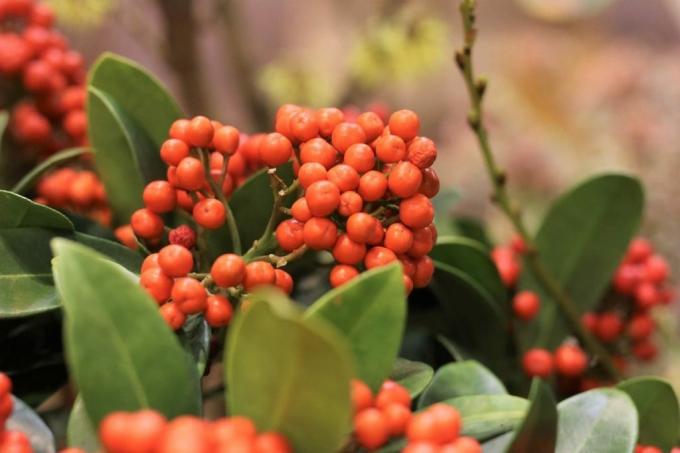
table of contents
- Soil condition
- Ideal location
- Bucket cultivation
- Change of location
- frequently asked Questions
Skimmia Japonica is so popular with many hobby gardeners because it is a great eye-catcher in the winter garden with its bright red fruits. But the Skimmia needs a special location for this. You can find out what it looks like here.
In a nutshell
- Place with light or partial shade ideal for the evergreen plant
- Avoid windy place, leaves leaves easily break off
- Keep the soil condition in the bed similar to rhododendron soil
- Shrubs can also be grown in pots
- Winter ornamental plant that does not require any special precautions for overwintering
Soil condition
Skimmia japonica is one of the diamond plants that have similar demands on the soil, such as a rhododendron:
- acidic pH is ideal
- Bog bed favorable texture
- feels like the forest floor
- Soil should also be humus and loose
- permeable
- Avoid waterlogging due to heavy soil
- Rhododendron soil is very suitable
- alternatively fold in peat, compost and granite flour

Tip: The Skimmia is absolutely frost hardy, so it does not need winter protection. Only the soil around the plant should be mulched, which not only protects against frost, but also against dehydration in winter.
Ideal location
Like all winter ornamental plants, the Skimmia has very special requirements when it comes to the ideal location. For this, the origin must be known in order to offer the ideal place. The plants originally come from the mountain forests in Japan. There is a lot of shade here from the tall trees. The cold-loving plants therefore do not tolerate a lot of heat and blazing midday sun in summer:
- slightly dark location
- Partial shade to the shade
- protected
- nevertheless airy and free
- Front yard ideal
- when the shadow of the house falls
- under tall trees
- also in the vicinity of conifers
- Avoid windy locations
- leaf damage could follow here
Bucket cultivation
Cultivation in the bucket is quite possible if there is a possibility that it can be kept outdoors all year round. Cultivation in the home is not an option:
- too warm in winter
- no possibility for pollination by bees
- no flower formation
- no fruit
- also unsuitable winter garden

More suitable locations for the Skimmie are instead:
- in the bucket on the terrace or balcony
- East or west balcony
- slightly shaded terrace
- in the covered, shady entrance area
Change of location
If the ideal place was not taken into account when planting the shrub, it will not be a problem in the first few years to move the Skimmia to another place in the garden. Here, however, various things must be observed so that the evergreen plant is not damaged:
- Note age
- no later than at the age of four to five years
- Size is not decisive here
- transplant during hibernation
- Choose a frost-free day
- Late autumn or late winter
- watch out for roots when digging
- Cut back the plant vigorously before moving it
- so energy can be directed towards new roots
frequently asked Questions
If it is too sunny in the location, especially in summer, then the constant irradiation of the plant does not appeal. Because in its native Asia it grows mainly in the undergrowth. In strong sunlight, the evergreen leaves can burn and, in the worst case, they will not bloom because the plant is simply too hot. In this case, the bright fruits on the bush are missing even in winter.
If the growing area of a Skimmia that is more than five years old is no longer ideal, for example because an object that was previously shady has disappeared, an older shrub can still be moved. To do this, however, it must be prepared. In autumn the crop is cut back by a third. The old roots are cut off around the root ball so that the plant can form new ones. The plant will not be implemented until the next hibernation.
Even if the location has the best conditions for the wood, the shrub needs other representatives of its species in the immediate vicinity. Because only when male and female shrubs are cultivated together can the picturesque winter decorations be formed in the form of the bright red fruits.
The Skimmia is an evergreen shrub that produces beautiful flowers. It belongs to the diamond family (Rutaceae). The bright red berries bring a colorful patch of color into an otherwise dreary winter garden, especially in the dreary winter time. Therefore the shrub belongs to the winter ornamental plants. Its pink flowers bloom in late summer, the berries hang from autumn to spring on the slow-growing shrub, which can be up to 1.5 meters high.
